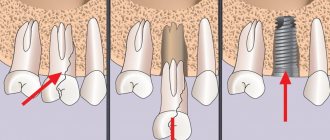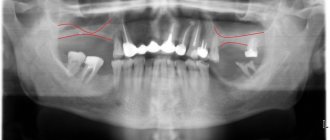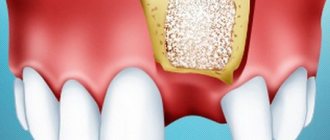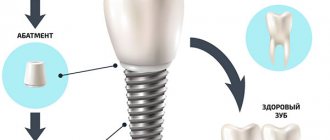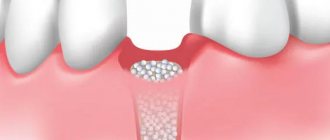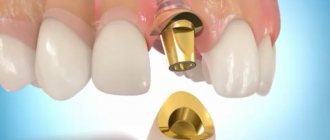Implantation is the replacement of a lost tooth with an artificial one. For an implant to function like a natural tooth, it must be securely secured. Unfortunately, as soon as we lose a tooth, the bone tissue begins to decrease. Over time, the atrophy becomes so pronounced that there is simply nowhere to insert the metal pin; there is not enough space for it.
In the upper jaw, bone loss is accompanied by a descent of the maxillary sinus membrane. As a result, there is not enough bone volume, and there is also a risk of membrane perforation during surgery.
Dentists have developed a bone grafting method that lifts the wall of the maxillary sinus. They called it sinus lifting, from the words “sinus” (maxillary sinus) and “lift.”
How it's going
Sinus lifting and implant installation are possible with open and closed methods. Whatever method the doctor chooses, it all starts with preparation. The implantologist assesses your general health and treats your gums if necessary. Blood tests make it possible to rule out infections and inflammatory processes. It is important to tell your doctor about allergic reactions.
A panoramic image (orthopantomogram) and CT will help assess the condition of the jaw, indications for implantation and augmentation. Installation of implants immediately after sinus lift is possible if the bone thickness is 5 mm or more. A CT scan will also show the presence of inflammatory processes in the maxillary sinus, cysts or tumors for which surgery cannot be performed.
Limitations after sinus lift and implant installation
Temporarily after simultaneous bone grafting and installation surgery, you must avoid:
- a hard toothbrush,
- hard and hot foods,
- baths and saunas,
- flights,
- physical activity,
- alcohol,
- cigarettes.
Try to chew foods carefully, without touching the operated area. Brush your teeth carefully, avoid sudden movements. For 1.5-2 months after the procedure, it is not recommended to dive, engage in extreme sports, or lift weights.
After the operation, the doctor will give precise recommendations and tell you in more detail about the restrictions that must be followed in your case. Completing all the specialist’s prescriptions, on the one hand, will ensure a quick recovery, and on the other hand, will eliminate the risk of complications.
Implantation with closed sinus lift
The skill of the doctor plays a decisive role in the success of any operation, but with a closed protocol, it is doubly important. The doctor approaches the membrane blindly; a lot depends on experience and intuition.
A bed for the implant is formed in the bone. Through it, the membrane is lifted with a special tool. The resulting cavity is filled with bone material and compacted. Then the pin is screwed in. The screw threads of these pins further compact the bone material as they move, increasing primary stability.
1 - formation of the hole, 2 - raising the bottom of the sinus, 3 - filling with bone material, 4 - installation of the implant
Indications for sinus lift: when is a sinus lift necessary?
A dental CT scan will help determine whether there are indications for a sinus lift. A three-dimensional image allows you to assess the size and density of the bone, plan implantation, and, if bone augmentation is necessary, determine the condition of the sinuses and the presence of ENT diseases.
It is difficult for the patient to understand the nuances. Therefore, it is better to talk to your doctor about the indications, and he will advise you when a sinus lift is necessary. However, it should be remembered that the length of the implant must be at least 10 mm. And if the bone is less than 8 mm high, then there are indications for a sinus lift. The need for extension is described in more detail in the corresponding article.
Open sinus lift with immediate implantation
This protocol seems more complex, but in fact the implantologist sees the surgical field, the risk of perforation is low.
The doctor creates a surgical window in the bone, lifts the shell, installs a protective membrane, and fills the hole with bone material. Then the implant is installed and the wound is sutured.
1 - formation of a hole in the bone, 2 - raising the bottom of the sinus, 3 - filling with bone material, 4 - installation of an implant
Contraindications to the procedure
Osteoplasty is not possible in the presence of acute immune diseases of the body (AIDS, HIV). Contraindications also include oncology, bleeding disorders, problems of the cardiovascular system, decompensated diabetes mellitus, too close to the bottom of the maxillary sinus (which makes it impossible to displace the membrane).
The presence of acute ENT diseases, caries or stomatitis are relative contraindications. Before surgery, it is imperative to completely cure a runny nose of any etiology (and constantly relieve allergic/medicinal rhinitis), as well as sanitize the oral cavity to minimize the risk of wound infection and other complications.
Rehabilitation
Recovery takes about a week
.
The duration of the rehabilitation period depends on the individual characteristics of the body and the type of operation. With an open protocol, swelling is greater and lasts longer. When closed, everything returns to normal in 3-4 days
.
On these days it is necessary:
- strictly follow the instructions;
- take antibiotics, analgesics;
- rinse your mouth with antiseptics;
- avoid hot, cold;
- eat soft, crushed food;
- limit physical activity;
- avoid temperature changes.
Methodology
Using the sinus lift technique with simultaneous implantation requires careful preparation and examination of the patient. Before treatment, the doctor must make sure that there are no contraindications, select an anesthetic, and choose surgical tactics and implants. All stages of surgical planning take place taking into account the patient’s wishes. Stages of bone augmentation and installation of structures:
- Complete pain relief.
- An incision is made and the gum is peeled off.
- Access to the maxillary sinus is created.
- Artificial bone material is introduced.
- Implants are installed.
- The flap is placed on the gum and the tissue is sutured.
- The patient is given recommendations:
- Oral baths with an aqueous solution of Chlorhexidine 0.02% (Paradontax) from tomorrow 3-4 times a day after meals for 5 seconds
- Do not blow your nose (dry your nose), or sneeze with your mouth open. Do not fly for 2 weeks
- Refusal of active physical activity for 3 days. Do not take a warm bath or go to the sauna for 2 weeks
- Stop smoking for 2 weeks
- Brush your teeth in the surgical area only with a surgical soft toothbrush starting tomorrow for 10 days.
- Medication support in the postoperative period
To the list of posts
Possible complications
Complications are possible with any surgical intervention; installation of implants after sinus lift is no exception. The most common problem is perforation of the maxillary sinus membrane. A small perforation is not so dangerous, there is no reason to refuse the operation, but if the diameter is large, the procedure will have to be stopped. Also happens:
- Sinusitis
. Inflammation of the sinuses with accumulation of pus. - Fistula formation
. When an infection enters a surgical wound, it “eats” the bottom of the maxillary sinus. A passage into the oral cavity is formed. - Bleeding
. As a result of vascular damage, severe blood loss can occur. - Implant rejection
. The survival rate of implants from well-known manufacturers is 99%. Unfortunately, there are cases when the artificial root is rejected by the body. Therefore, it is important to tell your doctor about all diseases, allergies, and body characteristics in order to exclude the possibility of rejection.
A good clinic has equipment and tools to eliminate the consequences, but the main thing is prevention. In this case, the implantologist is highly qualified. The more experienced the doctor, the less likely he is to make a mistake.
Simultaneous bone augmentation and implant placement – advantages
If a clinical case allows a doctor to simultaneously perform bone augmentation surgery and install implants, then he will definitely take advantage of this. This is easy to explain if you consider all the advantages of combining procedures:
- Saving time . On average, it is possible to save from 3 to 6 months - both procedures are performed at one appointment, so the patient does not need to wait until recovery after sinus lift is completed;
- Efficiency . Sinus lifting is one of the main methods of bone grafting, so its combination with dental implantation allows you to achieve excellent results without a long wait;
- Safety . The risk of complications when contacting an experienced doctor is excluded. Sinus lifting with one-stage implantation is a 100% safe procedure that allows you to restore the integrity of the dentition.
Features of rehabilitation after bone block transplantation
When growing bone using the autotransplantation method, donor material is taken from the patient’s body and transplanted to a new location. Therefore, a significant difference from other methods of osteoplasty is that after the operation the patient is left with not one, but two intervention sites. In this case, the patient needs to be as attentive as possible in relation to the oral cavity, carry out hygienic procedures with caution, do not touch the injured areas with a brush and do not pick them with the tongue.
Features of preparation for treatment
Before undergoing a sinus lift for dental implants, you need to undergo an examination and draw up a treatment plan. Because diagnosis and careful planning are the key to the success of operations and will eliminate possible errors and complications. We will consider below what the patient will need to do before restoring teeth:
- undergo an X-ray examination: it is better to have a cone beam or multislice computed tomography, because they provide a three-dimensional image that reflects the true state of the bone tissue and maxillary sinuses,
- cure dental diseases: caries, pulpitis, stomatitis,
- undergo professional oral hygiene: remove tartar and plaque, which are a source of accumulation of microbes,
- cure ENT pathologies: rhinitis, sinusitis, sinusitis, etc.,
- undergo tests: the operation is recommended if there are no inflammatory processes in the body, blood clotting disorders, or high blood pressure - otherwise complications are possible.
Treatment planning is carried out by a dental surgeon (implantologist), who, based on CT images, selects suitable types of implants, determines the exact location of their installation and the depth of immersion, taking into account the augmented bone. Also, the doctor will be able to “rehearse” a future intervention in the virtual space.
Why do you need to combine operations?
Combining implantation and sinus lift offers several key benefits. Firstly, this is a reduction in surgical interventions that extend over time - less tissue trauma, fewer anesthetics and only 1 rehabilitation period. Secondly, there will be an implant (analogous to a root) inside the planted bone, so the bone chips have a better chance of taking root - it will completely become the basis for the young own bone around the implant. For comparison, conventional osteoplastic procedures (without simultaneous implantation) have an effectiveness of only 40-60%, because the bone either does not take root or takes root poorly. Such patients have to go through extensions one or two more times.
“I wanted to get an upper tooth implant for a long time, but there was no time. Moreover, the hole is on the side and is not visible. But it took a long time, as it turned out. The bone in this place was gone, and we had to build it up. Only after this the doctor was able to place the implant. And the crown was done only six months later. It turns out that all this torture and treatment dragged on for almost a year and a half.”
Karina_91, review from the woman.ru forum
Is it possible to perform implantation without bone grafting?
The only alternative to bone grafting (excluding prosthetic methods without the use of implants, i.e. removable and bridge prostheses) is a one-stage implantation protocol with immediate loading. However, without a bone augmentation procedure, it is used only for multiple restorations, since in order to fully support the prosthesis in conditions of bone tissue atrophy, it is necessary to install at least three implants both for a segment of teeth and for prosthetics of a full row.
Read more about methods of dental implantation in 1 day WITHOUT bone grafting >>>
Types of operations in dentistry
Implantologists around the world have been using augmentation for more than 30 years to create a strong foundation for dental implants in the upper jaw. How is a sinus lift done? There are only 2 main types of procedures:
- closed or soft: if the bone height is more than 5 mm,
- open: if the alveolar ridge bone height is less than 4 mm.
A number of clinics offer a procedure called Bio Sinus Lift. In essence, this is a standard operation, but with a “selling” name. The difference between this method is that only natural materials without synthetics are used for augmentation: auto- or xenografts. Or if during the operation a biological clot is implanted - a PRF membrane.
Osteoplasty is performed without incisions in the skin and muscles of the face; all work is carried out from the oral cavity. Regardless of the type of operation, the procedure is performed under anesthesia. If the patient is very afraid, xenon sedation or general anesthesia is possible. But usually standard anesthesia is sufficient - a sinus lift lasts about 30-60 minutes. When are sutures removed after surgery? After about 5-10 days - depending on the size of the operated area.
Another “advertising variety” is ultrasonic sinus lifting. In fact, this is not a separate procedure, but a companion technique for open and closed types, and for other methods of bone augmentation. The bottom line is that the dentist uses a special ultrasonic device as a bur - a piezotome. Also, instead of a scalpel, a laser beam can be used.
Closed type of procedure
What is a closed sinus lift - this is the name of the procedure with minimal trauma to the gingival and bone tissues, when the bottom of the sinus and bone grafting is carried out through a small vertical hole in the lower part of the alveolar ridge. As a rule, a one-way method is used – i.e. restoration of teeth from only one part of the row. This is the simplest (for the patient) type of operation. This is explained by the fact that when replanting bone material, implants are usually installed immediately, that is, the use of simultaneous dental implantation. How is a closed operation performed? Let's consider all the stages in order:
- Stage 1: one or more holes are created in the gum and then in the bone (according to the number of implants). The doctor acts very carefully so as not to damage the sinus lining (this is why CT data is needed).
- Stage 2: the necessary instruments are inserted through the “passages” formed in the bone, and the bottom of the nasal sinus is carefully shifted,
- Stage 3: the resulting cavity is gradually filled with artificial bone and fibrin clot,
- Stage 4: Immediately after placing the transplant, implants are installed - holes through which osteoplasty is carried out, their dimensions are specially created. Next, plugs are screwed into the implants,
- Stage 5: a collagen membrane is applied (it holds the implanted bone and promotes regeneration), the gum is sutured.
The main condition for a closed-type operation is the presence of the patient’s own bone of 5 mm or more in height (which is required for the primary fixation of titanium implants). Using the procedure, you can install 1-3 implants at the same time.
How does a closed sinus lift work? It can be carried out in two ways:
- balloon method: lifting with air using a special ball, which, when inflated, lifts the bottom of the sinus. Refers to the most gentle and safe technique,
- mechanical: the mucous membrane is carefully lifted with hand instruments.
Open procedure type
What is an open sinus lift and how is it done? The open type is a complex and complete surgical operation, the indication for which is a pronounced lack of bone substance or the absence of more than 3 chewing teeth in a row. To raise the bottom of the maxillary sinus and introduce bone material, several small holes are not enough (as in the previous method). First, a gingival flap is peeled off in the projection of the sinus. Then the doctor performs an osteotomy - cutting out a large “window” on the side of the bone. Then the lining of the maxillary sinus is lifted. As a result of manipulations, a little free space is freed up. The operation can then continue in 2 scenarios:
- with one-stage implantation (installation of implants): if the lack of bone is 5-6 mm, then the implants can be installed immediately - you just have to additionally make vertical holes for them from below. Then the graft is introduced through the side “window”, a membrane is applied (if necessary), and the gum flap is sutured,
- without immediate installation of implants: bone material is inserted and a membrane is applied. Next, the gum flap is placed in place, stitches are applied, and after 3-4 months the implants can be placed. This type of open osteoplasty is used when the initial bone height is 4 mm or less.
During the creation of an opening in the bone, perforation of the sinus lining may occur. The doctor may stitch it up and continue with the sinus lift, or put stitches and postpone surgery until it is completely healed. To avoid the risk of damage to the mucosa, which adheres quite tightly to the bone, the best option would be to choose a piezoelectric tip with diamond coating. Such an instrument creates vibrations rather than rotation, so the osteotomy is performed with greater precision.
In what cases do they refuse immediate prosthetics?
They try not to combine simultaneous implantation with sinus lift and immediate prosthetics. Let's find out why. Immediate prosthetics means that the prosthesis on the implant will be installed immediately or 3-7 days after the surgical stage. And with such a prosthesis it will be possible to immediately chew food. But in the situation under consideration this is dangerous, because The implant may shift due to the load and be pressed into the sinus. Therefore, implants are most often closed with a plug and sutured with gums, left alone for 6 or even 9 months so that they fully take root. And only after this will it be possible to place the prosthesis on the implants. And while waiting for such prosthetics, the patient walks with temporary dentures fixed on the gums or on supporting teeth.
Recommendations after surgery
All necessary recommendations and rules of behavior are contained in a black bag with medications.
During the recovery period you need:
- follow doctor's orders, take medications (antibiotics, analgesics);
- treat the oral cavity with an antiseptic solution;
- take warm, finely ground food (3-5 days);
- When brushing your teeth, avoid the operated area; clean it carefully with a cotton swab;
- chew on the opposite side;
- Cough and sneeze with extreme caution.
Temporarily during the rehabilitation period it is prohibited:
- drink liquid through a straw;
- touch the operated area with your hands;
- blow your nose;
- go in for sports, diving;
- fly on a plane;
- smoke, drink alcohol;
- visit the bathhouse, sauna, solarium;
- supercool.
More about the recovery period - After a sinus lift
